EPON / GPON-network. Is the choice obvious?
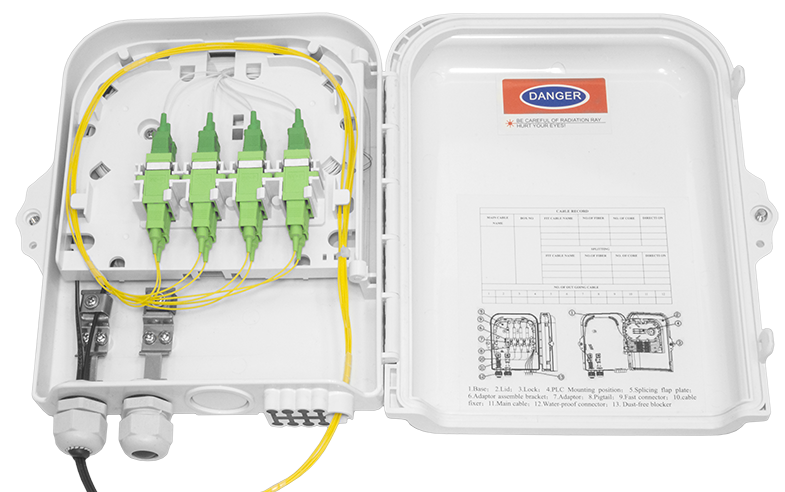
The penetration of the Internet in the cities of one million people according to FOM at the beginning of 2015 was already 80%. The network covers residents of almost all apartment buildings. Overboard are only residents of the private sector. For telecom operators, it is the development of private households that can be an option to expand their subscriber base, but this is not so simple. Taking this segment through FTTB networks is not so easy, DSL is hopelessly outdated, Wi-Fi is fast and legal only in glossy brochures. But xPON managed to fall in price literally to the obscene. And dwell on it in more detail.
The benefit of using xPON today is more obvious than ever: from a single point of presence, you can connect all the houses within a radius of several kilometers without installing active communication centers. With a sharp decline in the price of technology, this option becomes acceptable for many companies.
Before dwelling on the use of xPON (examples of equipment EPON or GPON ), it is worth emphasizing that vendors such as BDCOM, Eltex and HUAWEI have long been providing devices running on both PON development branches. The difference in price tags, speeds and opportunities between them is not important. Is that the EPON connects up to 64 subscriber devices per port, and GPON allows you to connect 128 subscribers. At the same time, chips for EPON have already appeared on the market, allowing to include up to 128 ONUs per port. Now only Eltex has a solution in their TurboGepon, and even then, with differences from the standard, however, it does not make much sense to attribute this feature to real problems.
')
And that's why. The budget, relying on the decision with 128 ONU, should be perfect for high-rise buildings, but there are some nuances. Typical level of penetration usually reaches 10-15%. Moreover, it is impossible to predict in advance the places of appearance of subscribers. As for the new customer, it is impossible to personally pull in the house wiring to each new customer - PON is very sensitive to the quality of welding and installation.
Consider the layout for typical high-rise buildings.

Scheme using optical division 1: 128
In order to make it comfortable to use “division by 128” for EPON, it is necessary to take end dividers with a margin - then the apartment capacity will be covered by 50%. For example, on the floor where there are 8 apartments a divisor is placed on 4. In another version, we put the divisor on 8 through each floor.
At the house level, the averaged statistics still gives the result - the real connected subscribers will be no more than 25% of the number of apartments in the house, which gives 64 clients from the PON port. In this case, the GPON port will remain only half loaded.
Private sector
The residential sector, built up with low-rise construction, in general, has no fundamental differences from high-rise buildings. As an example, take the small town of Sysert in the Sverdlovsk region. The private sector here makes up the bulk of the development. The layout in this area is made to cover 50% penetration. An eight-core cable is used as a trunk cable.

Just a few years ago, such areas did not attract the attention of companies. Low density coupled with long distances made the construction of the network expensive and unprofitable. To do everything at once, with a reserve in an apartment building, is long and expensive. Therefore, the work is conducted from time to time, with different cables and, more importantly, with different hands. As a result, the optical budget does not withstand the "division by 128". And if so, then when choosing between GPON and EPON, there is not much difference.

Dividers
There are no principal differences in the variety of dividers. All of them are visible in the pictures below.
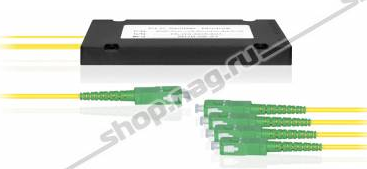

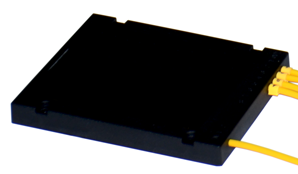
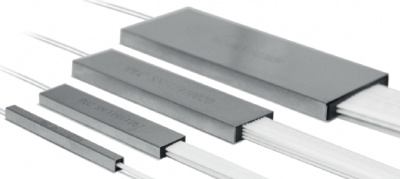
We present the most popular models and approximate prices for them:

How does it look in clutches?
This is what a pass coupling with a 1: 8 divider of the first level installed

If there is a need, then two dividers can be placed in the coupling. In this situation, the inclusion of nearby subscribers allows you to do without the junction box.
Here is an example with the dividers of the first level 1: 8 and at the same time the divider of the second level 1: 8

This placement involves sealing the output of subscriber cables with the help of available tools.

If you use a junction box, then everything looks even easier.
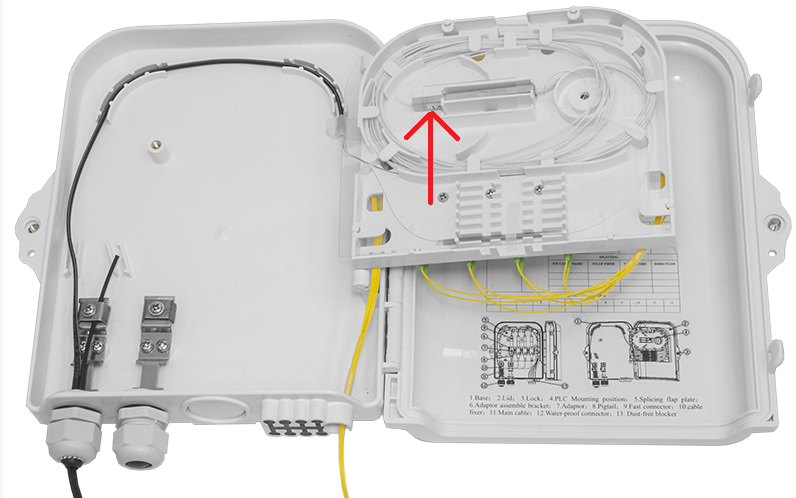
Type of connection subscriber endings.

An example of connecting the subscriber from the coupling.

Speed
The size of the subscriber’s appetite for consuming traffic substantially depends on the social profile. Understand how help the table below.
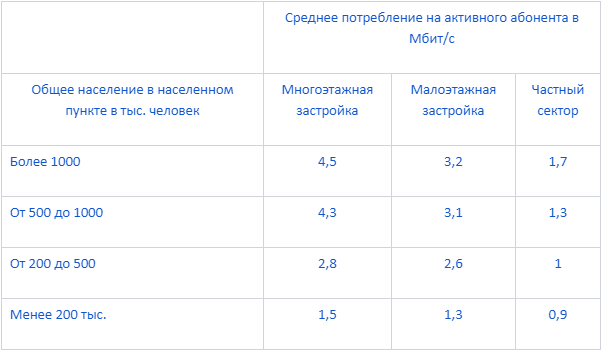
Separately, I would like to make out the traffic consumption when using the IPTV service. Almost every operator on average provides its subscribers with 150-200 channels. The total traffic at the same time easily reaches 1000 Mbit / s. Downloading to one PON port is determined only by the number of channels that the subscriber watches from a specific port. Statistics tell us that their number does not exceed 20. The share of “heavy” HD channels will be approximately 50% of this number.
The bitrate for HD will be 15 Mbps, the bitrate for SD channels is 5 Mbps. We calculate the final consumption: 10 * 15 + 10 * 5 = 200 Mbit / s. The total average consumption for one PON-port with 100% activity of all clients (including inclusion divided by 64) will be equal to 64 * 4.5 Mbit / s + 200 Mbit / s = 488 Mbit / s. When you turn on 128 clients - 128 * 4.5 Mbit / s + 200 Mbit / s = 776 Mbit / s. This is loading one port under the most optimistic scenario, when all clients are connected and active.
As can be seen from the speed calculations, EPON is quite enough, and the GPON speed, although higher, does not give us any real advantage. Accordingly, in this case there is no particular difference between the types of technology.
Initial investment
As a rule, the network is built either by laying highways with the organization of customer division points, or by the “carpet” method. In the first version, nodes arise randomly and are organized by installers who perform work. There are many cons. One of them is a high attenuation level. A sample of 20 providers allows you to say that the attenuation with this approach ranges from 24 to 30+ dB when building a network with a 1:64 division. In this case, it will hardly be possible to get a workable network with a 1: 128 ratio.
In the second case, equipment is immediately installed in the area, based on an optimistic level of penetration. This allows you to properly organize the trunk level, make a high-quality installation and get a real attenuation close to the calculated one. With this option of building a network, it is easy to achieve a 1: 128 division by one PON port.
In the first option of building a network, equipment is purchased at the expense of money received for the subscriber connection. Therefore, preference will be given to equipment with low cost. What are the solutions in terms of price?
The choice between EPON and GPON in rubles
Price comparison will be carried out on the example of a four-port solution. We will compare the average price on the market in rubles as of November 1, 2016.
EPON:

BDCOM P3310C with two power supply units and four PX-20 + SFP modules will cost ~ 70,000 rubles.
GPON:

Eltex - LTP-4X with two power supply units and four C + SFP-modules, will cost ~ 125 000 rubles.

Huawei - MA5608T c AC / DC power supply, 8 GPON-ports with eight SFP + modules C + will cost ~ 160,000 rubles.
As ONU / ONT, we will consider single-port models as the most budgetary and in demand.
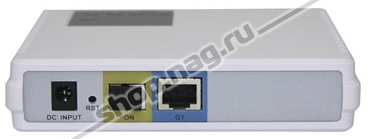
BDCOM P1501C1 will cost about 2046 rubles.

Eltex NTU-1 will cost about 2533 rubles.

Huawei HG8310M will cost about 2150 rubles.
The cost per customer is calculated according to the formula Scl = (Solt / Qp / N) + Sont, where:
Solt is the cost of OLT, Sont is the cost of ONT, Qp is the number of PON ports, N is the number of clients from one PON port.
The number of ports for Huawei will be considered equal to 4, to bring to a single configuration. For clarity, the results are summarized in the table:

The table clearly shows that in terms of price, EPON is more profitable compared to GPON solutions.
Consider prospects
When building an xPON network, you need to take into account that not all hardware is compatible with each other. That is why some vendors prohibit the use of competitors' equipment together with their own. Therefore, for a number of other reasons, it is better to stop your choice on equipment for which the joint work with alternative iron of another “company” will not become a stumbling block.
A great example is the EPON BDCOM devices. Compatible with other vendors that support the CTC 2. specification. Those who have already worked with OLT BDCOM are aware of alternative ONU models that successfully work in conjunction with OLT. Together with OLT Huawei, ONE by ZTE, Fiberhome and others successfully work. At the time of writing, the Eltex OLT did not allow working with third-party ONUs. Perhaps in the future it will change, but now it is worth paying attention to.
The consumption of traffic is growing every year and the moment when the xPON speed will not be enough, is coming. However, 10G xPON solutions are available on the market ( XG-PON and 10G-EPON should be understood as 10G xPON), allowing to provide 10G of downlink and 2.5G upstream traffic. Since 10G xPON for operation uses other wavelengths, it is possible to transfer clients from xPON to 10G xPON in stages. The distribution of wavelengths for different generations of PON can be clearly seen in the figure below.

A gradual transition from xPON to 10G xPON is possible with the installation of an additional OLT that supports 10G xPON or an additional fee (if you use a chassis, for example, Huawei). The signal from the ports of the new device using filters add to the existing xPON network and distribute new ONUs being transferred to 10G xPON clients. Unfortunately, the current price for 10G xPON is almost ten times higher than usual, which creates serious obstacles for mass adoption. Therefore, most likely, the transition to 10G xPON in the next five years is possible only for high-rise buildings.
This refers not to the “pure” 10G xPON, but to work in the combined mode. This is due to the fact that 90% of traffic generates 10% of subscribers, so it is economically justified to transfer them to the new PON, as well as connecting legal entities. individuals. It is also possible to use 10G xPON at the level of aggregation. In this situation, instead of the frequently used ring with STP, a ring of two independent cables is constructed to obtain a 1 + 1 scheme (type B). This method allows you to provide non-volatile, dual-beam connection of each switch.
Despite the fact that China has begun a massive transition to XG-PON (which has created a shortage of EML lasers for two years now, which has been felt by everyone who orders CWDM or DWDM modules over 40km) in Russia, in our opinion, the prospects for using 10G xPON in sectors of low-rise and private houses in the next 5 years are unlikely. In this segment, the cost of equipment is most important and a multiple increase in price is unacceptable. In the event of a shortage of xPON speed, operators will prefer to switch to a 32-user port switching scheme. TWDM PON technology will help to do this without changing the cable infrastructure. TWDM PON technology allows you to organize multiple PON channels in a single fiber using different wavelengths. Especially for this, 1270-1280 / 1570-1580 nm, 1535-1540 / 1553-1558 and 1535-1540 / 1570-1580 nm ranges are distinguished.
Summarizing the above, we will try to figure out how true some common statements are:
- GPON is faster than EPON. Of course, the maximum allowed downstream speed in GPON is greater, however, if 128 clients are connected to the beam, then the specific speed of one client will be equal to the variant with EPON, while the upward speed will be even less. In addition, the above we considered the traffic consumption typical for different types of customers, and obtained the necessary speed, which both EPON and GPON can provide. For this reason, we will consider a draw.
- GPON is more functional than EPON. The possibilities of GPON are wider, but if we discard the transfer of TDM, since the spread of E1 is extremely low. In GPON, by using detailed settings for speeds and priorities for each GEM port, you can better manage services and traffic for them. However, this significantly complicates the setup for small operators who do not have a configuration management system integrated with billing, this is more a minus than a plus. As for the widely used functionality, it is equally presented in both versions.
- GPON allows you to connect 128 clients to one port, which makes it ultimately cheaper. In the comparison section “EPON and GPON in rubles” we were able to see that EPON is cheaper than GPON solutions, even with the inclusion of 128 clients from one PON port.
Source: https://habr.com/ru/post/373763/
All Articles